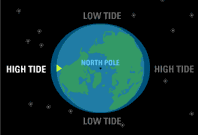|
Venice residents watch the Adriatic sea's rise and fall with anxious
eyes, keenly aware of how weather can affect its twice-daily ebb and
flow. But what is the primary cause of the tides there and
elsewhere? Despite what frequent Venice visitor Galileo Galilei
thought, tides are indeed related to the motion of the moon (and to
a lesser extent, the sun).*
Two oceanic bulges—one on the side of the Earth facing the
moon and the other on the side opposite from the moon—move in
relation to our satellite as it orbits us, causing in most places
two high tides a day as our planet rotates on its axis. The moon's
gravity pulls the ocean toward itself to create the near-side bulge,
but this doesn't account for the bulge on the far side.
Here, follow a step-through animation that explains why water rises
on the side of the Earth away from the moon.
-
What Causes the Tides?
(55K)
Requires
Flash plugin.
Non-Flash version
-
Tidal Curiosities
Why is there sometimes a lag of up to several hours between the
arrival of the moon overhead and the arrival of high tide? Why
do the biggest tides happen when the moon is full? And why is it
that sometimes, in some places, there is only one high tide (and
one low tide) in a day instead of two? Find out here.
* According to Galileo, tides were caused by the combined motion of
the Earth rotating on its axis and its movement around the sun. To
find out more, see
His Big Mistake within
the "Galileo's Battle for the Heavens" Web site.
|

|
|
Flash is a plug-in that allows for increased
interactivity. If you can see the animated boxes at
left, the plugin is already installed. If you do not see
the boxes, you can
install the Flash plugin, or select this feature's non-Flash version.
|
|
|
Further Reading
"Our Restless Tides." NOAA/NOS Web site,
http://co-ops.nos.noaa.gov/
restles1.html
"Tides and the Earth-Moon System," by Peter Goldreich.
Scientific American, April, 1972.
Bores, Breakers, Waves, and Wakes, by R.A.R.
Tricker (New York: American Elsevier, 1965).
|
|
|

